Contemporary Issues in Travel and Tourism: Technology and Trends
VerifiedAdded on 2024/05/14
|10
|2159
|484
Report
AI Summary
This report examines the significance of technological advancements in the travel and tourism industry. It discusses the historical development of technology, its impact on tourism, and reviews key theories like the diffusion of innovation and Porter's Five Forces. The report also explores concepts such as value chains, business models, disintermediation, and re-intermediation within the tourism sector. It further analyzes the changing nature of the tourism industry structure and evaluates the competitiveness of the industry, highlighting the importance of ICT and internet advancements for tour operators to enhance services, gain a competitive edge, and meet evolving consumer demands. The report concludes that continuous innovation and adaptation are essential for success in the increasingly competitive tourism market.
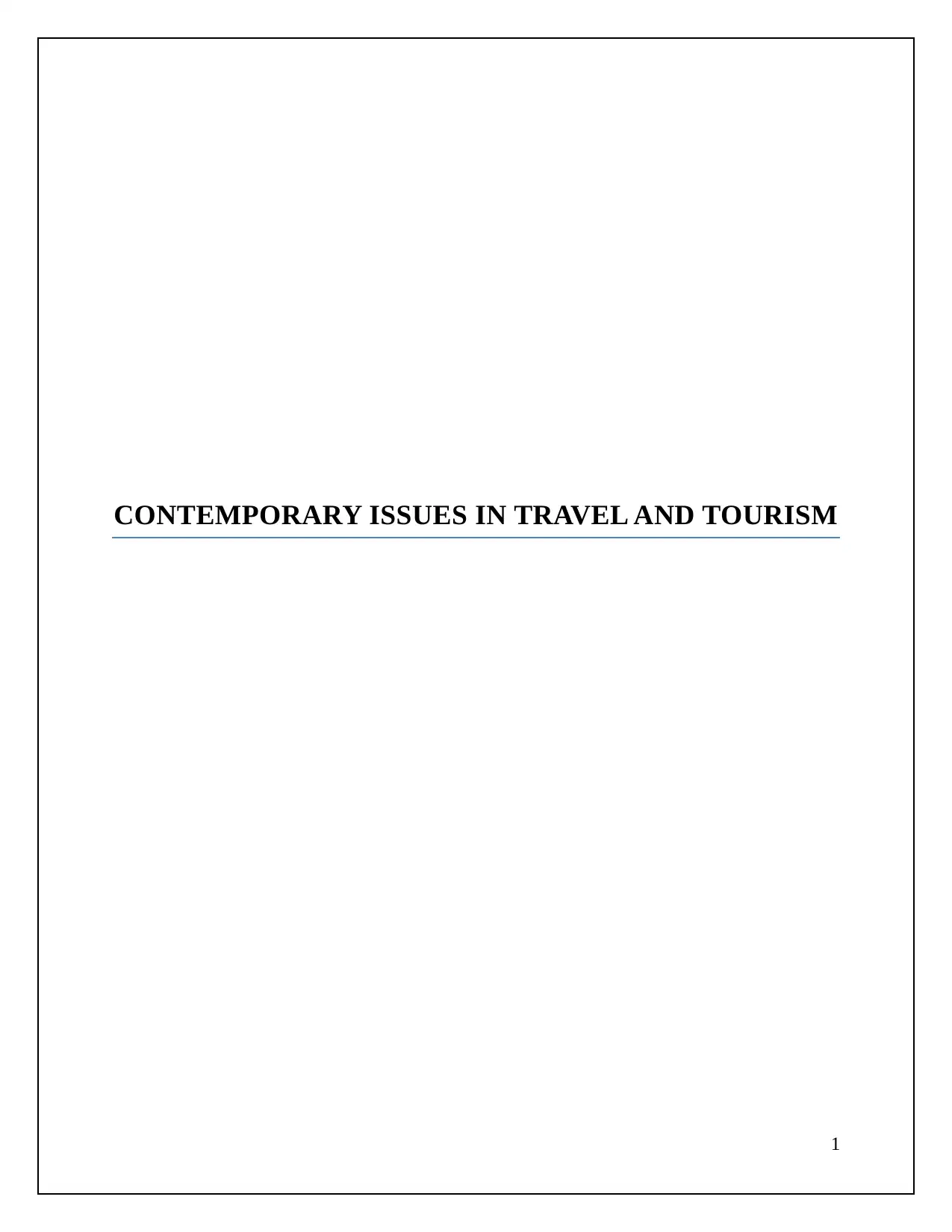
CONTEMPORARY ISSUES IN TRAVEL AND TOURISM
1
1
Paraphrase This Document
Need a fresh take? Get an instant paraphrase of this document with our AI Paraphraser
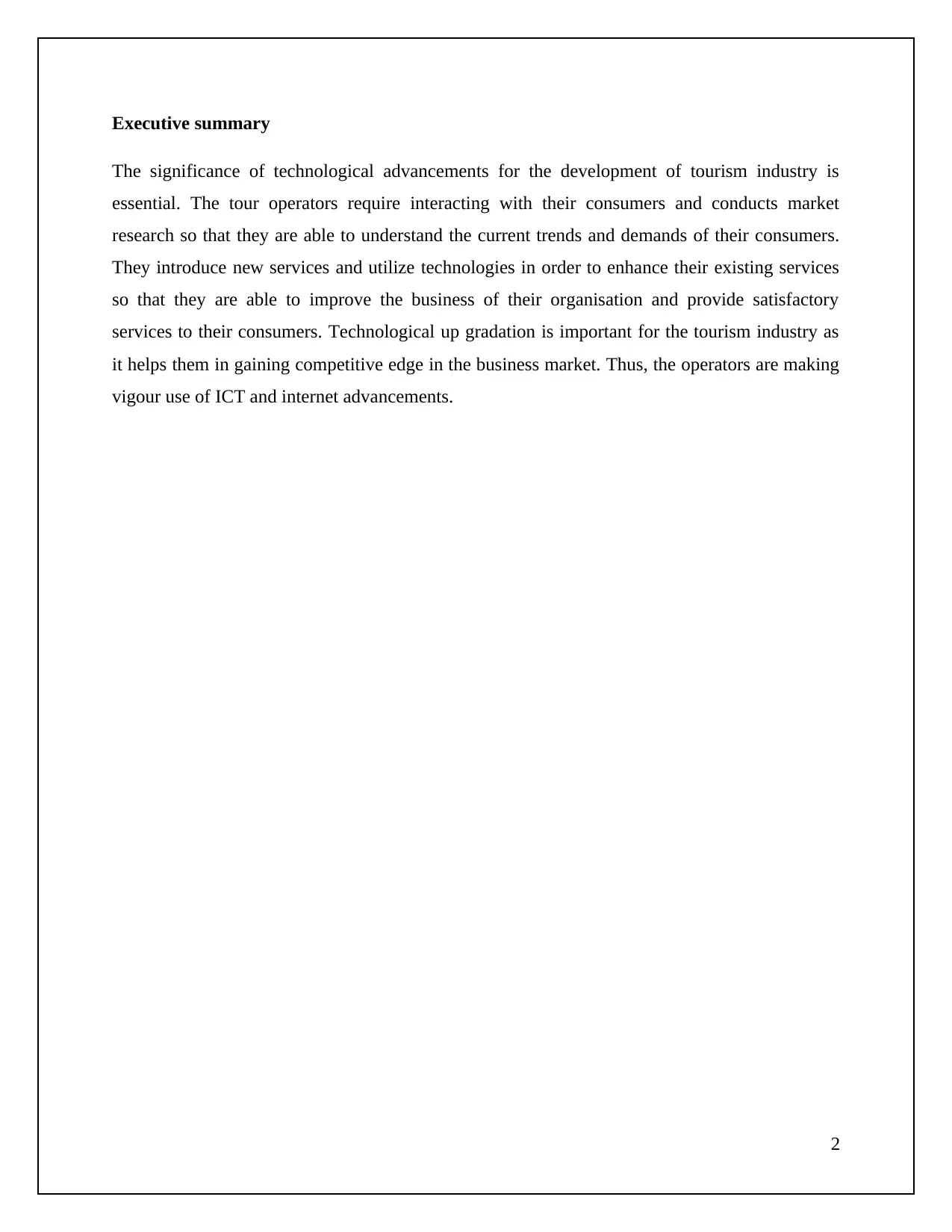
Executive summary
The significance of technological advancements for the development of tourism industry is
essential. The tour operators require interacting with their consumers and conducts market
research so that they are able to understand the current trends and demands of their consumers.
They introduce new services and utilize technologies in order to enhance their existing services
so that they are able to improve the business of their organisation and provide satisfactory
services to their consumers. Technological up gradation is important for the tourism industry as
it helps them in gaining competitive edge in the business market. Thus, the operators are making
vigour use of ICT and internet advancements.
2
The significance of technological advancements for the development of tourism industry is
essential. The tour operators require interacting with their consumers and conducts market
research so that they are able to understand the current trends and demands of their consumers.
They introduce new services and utilize technologies in order to enhance their existing services
so that they are able to improve the business of their organisation and provide satisfactory
services to their consumers. Technological up gradation is important for the tourism industry as
it helps them in gaining competitive edge in the business market. Thus, the operators are making
vigour use of ICT and internet advancements.
2
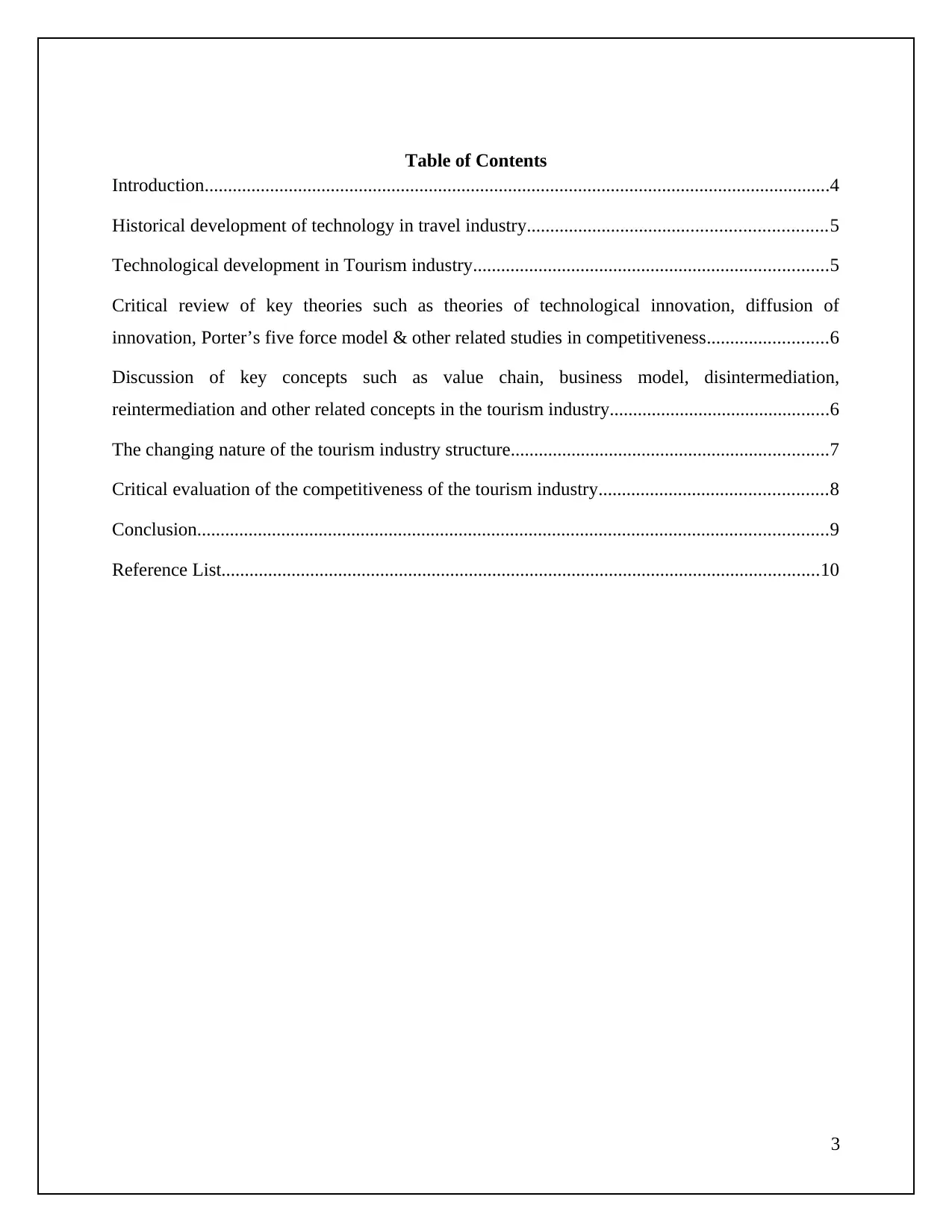
Table of Contents
Introduction......................................................................................................................................4
Historical development of technology in travel industry................................................................5
Technological development in Tourism industry............................................................................5
Critical review of key theories such as theories of technological innovation, diffusion of
innovation, Porter’s five force model & other related studies in competitiveness..........................6
Discussion of key concepts such as value chain, business model, disintermediation,
reintermediation and other related concepts in the tourism industry...............................................6
The changing nature of the tourism industry structure....................................................................7
Critical evaluation of the competitiveness of the tourism industry.................................................8
Conclusion.......................................................................................................................................9
Reference List................................................................................................................................10
3
Introduction......................................................................................................................................4
Historical development of technology in travel industry................................................................5
Technological development in Tourism industry............................................................................5
Critical review of key theories such as theories of technological innovation, diffusion of
innovation, Porter’s five force model & other related studies in competitiveness..........................6
Discussion of key concepts such as value chain, business model, disintermediation,
reintermediation and other related concepts in the tourism industry...............................................6
The changing nature of the tourism industry structure....................................................................7
Critical evaluation of the competitiveness of the tourism industry.................................................8
Conclusion.......................................................................................................................................9
Reference List................................................................................................................................10
3
⊘ This is a preview!⊘
Do you want full access?
Subscribe today to unlock all pages.

Trusted by 1+ million students worldwide
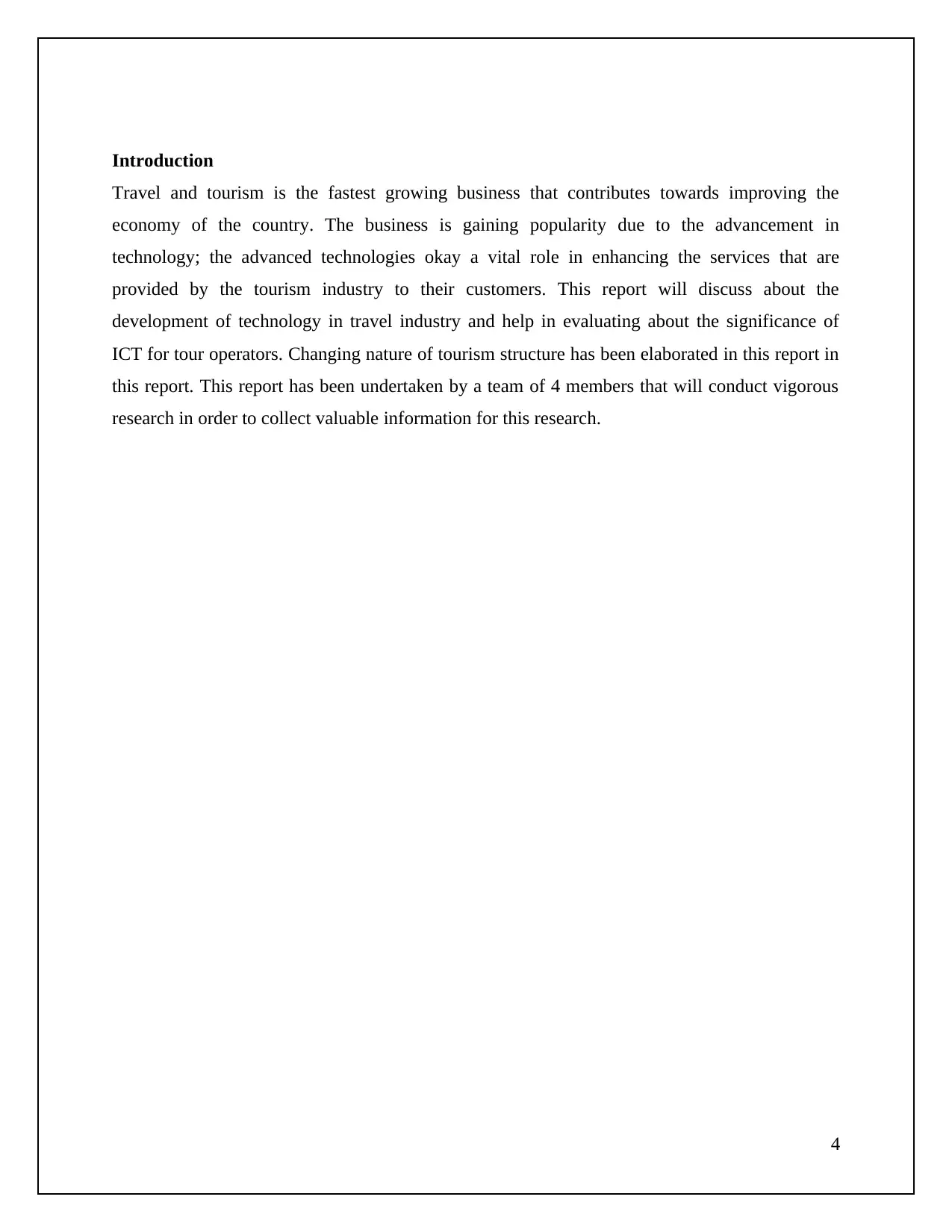
Introduction
Travel and tourism is the fastest growing business that contributes towards improving the
economy of the country. The business is gaining popularity due to the advancement in
technology; the advanced technologies okay a vital role in enhancing the services that are
provided by the tourism industry to their customers. This report will discuss about the
development of technology in travel industry and help in evaluating about the significance of
ICT for tour operators. Changing nature of tourism structure has been elaborated in this report in
this report. This report has been undertaken by a team of 4 members that will conduct vigorous
research in order to collect valuable information for this research.
4
Travel and tourism is the fastest growing business that contributes towards improving the
economy of the country. The business is gaining popularity due to the advancement in
technology; the advanced technologies okay a vital role in enhancing the services that are
provided by the tourism industry to their customers. This report will discuss about the
development of technology in travel industry and help in evaluating about the significance of
ICT for tour operators. Changing nature of tourism structure has been elaborated in this report in
this report. This report has been undertaken by a team of 4 members that will conduct vigorous
research in order to collect valuable information for this research.
4
Paraphrase This Document
Need a fresh take? Get an instant paraphrase of this document with our AI Paraphraser
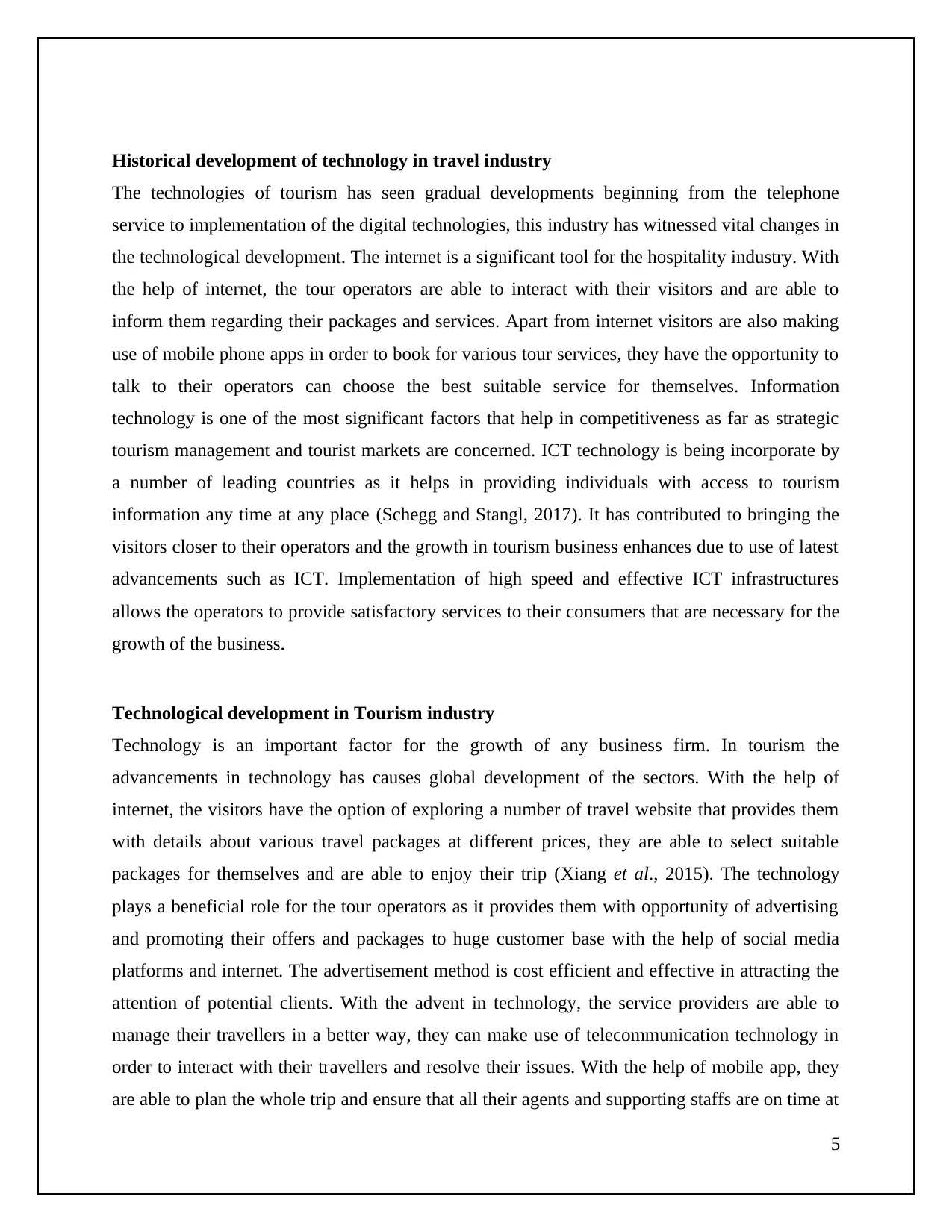
Historical development of technology in travel industry
The technologies of tourism has seen gradual developments beginning from the telephone
service to implementation of the digital technologies, this industry has witnessed vital changes in
the technological development. The internet is a significant tool for the hospitality industry. With
the help of internet, the tour operators are able to interact with their visitors and are able to
inform them regarding their packages and services. Apart from internet visitors are also making
use of mobile phone apps in order to book for various tour services, they have the opportunity to
talk to their operators can choose the best suitable service for themselves. Information
technology is one of the most significant factors that help in competitiveness as far as strategic
tourism management and tourist markets are concerned. ICT technology is being incorporate by
a number of leading countries as it helps in providing individuals with access to tourism
information any time at any place (Schegg and Stangl, 2017). It has contributed to bringing the
visitors closer to their operators and the growth in tourism business enhances due to use of latest
advancements such as ICT. Implementation of high speed and effective ICT infrastructures
allows the operators to provide satisfactory services to their consumers that are necessary for the
growth of the business.
Technological development in Tourism industry
Technology is an important factor for the growth of any business firm. In tourism the
advancements in technology has causes global development of the sectors. With the help of
internet, the visitors have the option of exploring a number of travel website that provides them
with details about various travel packages at different prices, they are able to select suitable
packages for themselves and are able to enjoy their trip (Xiang et al., 2015). The technology
plays a beneficial role for the tour operators as it provides them with opportunity of advertising
and promoting their offers and packages to huge customer base with the help of social media
platforms and internet. The advertisement method is cost efficient and effective in attracting the
attention of potential clients. With the advent in technology, the service providers are able to
manage their travellers in a better way, they can make use of telecommunication technology in
order to interact with their travellers and resolve their issues. With the help of mobile app, they
are able to plan the whole trip and ensure that all their agents and supporting staffs are on time at
5
The technologies of tourism has seen gradual developments beginning from the telephone
service to implementation of the digital technologies, this industry has witnessed vital changes in
the technological development. The internet is a significant tool for the hospitality industry. With
the help of internet, the tour operators are able to interact with their visitors and are able to
inform them regarding their packages and services. Apart from internet visitors are also making
use of mobile phone apps in order to book for various tour services, they have the opportunity to
talk to their operators can choose the best suitable service for themselves. Information
technology is one of the most significant factors that help in competitiveness as far as strategic
tourism management and tourist markets are concerned. ICT technology is being incorporate by
a number of leading countries as it helps in providing individuals with access to tourism
information any time at any place (Schegg and Stangl, 2017). It has contributed to bringing the
visitors closer to their operators and the growth in tourism business enhances due to use of latest
advancements such as ICT. Implementation of high speed and effective ICT infrastructures
allows the operators to provide satisfactory services to their consumers that are necessary for the
growth of the business.
Technological development in Tourism industry
Technology is an important factor for the growth of any business firm. In tourism the
advancements in technology has causes global development of the sectors. With the help of
internet, the visitors have the option of exploring a number of travel website that provides them
with details about various travel packages at different prices, they are able to select suitable
packages for themselves and are able to enjoy their trip (Xiang et al., 2015). The technology
plays a beneficial role for the tour operators as it provides them with opportunity of advertising
and promoting their offers and packages to huge customer base with the help of social media
platforms and internet. The advertisement method is cost efficient and effective in attracting the
attention of potential clients. With the advent in technology, the service providers are able to
manage their travellers in a better way, they can make use of telecommunication technology in
order to interact with their travellers and resolve their issues. With the help of mobile app, they
are able to plan the whole trip and ensure that all their agents and supporting staffs are on time at
5
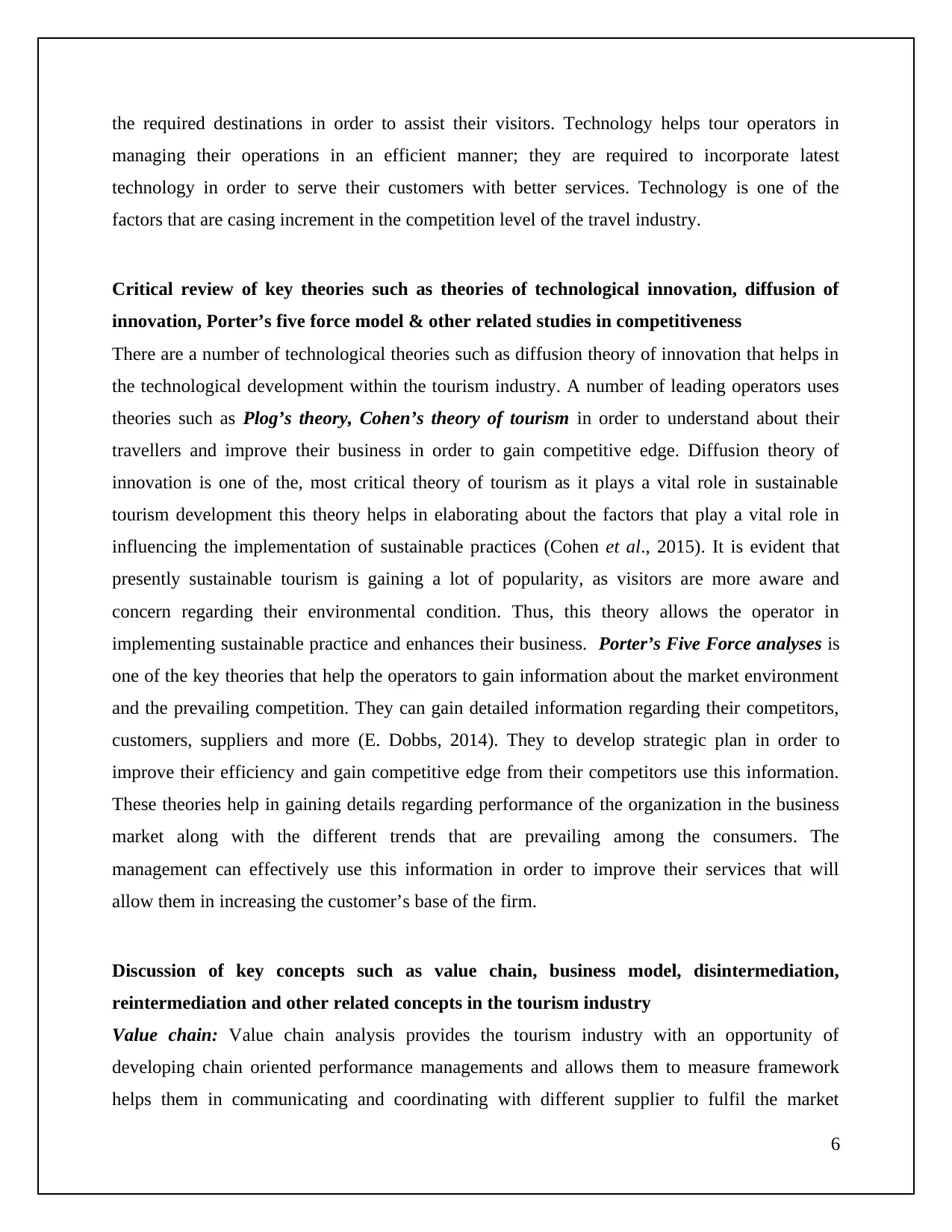
the required destinations in order to assist their visitors. Technology helps tour operators in
managing their operations in an efficient manner; they are required to incorporate latest
technology in order to serve their customers with better services. Technology is one of the
factors that are casing increment in the competition level of the travel industry.
Critical review of key theories such as theories of technological innovation, diffusion of
innovation, Porter’s five force model & other related studies in competitiveness
There are a number of technological theories such as diffusion theory of innovation that helps in
the technological development within the tourism industry. A number of leading operators uses
theories such as Plog’s theory, Cohen’s theory of tourism in order to understand about their
travellers and improve their business in order to gain competitive edge. Diffusion theory of
innovation is one of the, most critical theory of tourism as it plays a vital role in sustainable
tourism development this theory helps in elaborating about the factors that play a vital role in
influencing the implementation of sustainable practices (Cohen et al., 2015). It is evident that
presently sustainable tourism is gaining a lot of popularity, as visitors are more aware and
concern regarding their environmental condition. Thus, this theory allows the operator in
implementing sustainable practice and enhances their business. Porter’s Five Force analyses is
one of the key theories that help the operators to gain information about the market environment
and the prevailing competition. They can gain detailed information regarding their competitors,
customers, suppliers and more (E. Dobbs, 2014). They to develop strategic plan in order to
improve their efficiency and gain competitive edge from their competitors use this information.
These theories help in gaining details regarding performance of the organization in the business
market along with the different trends that are prevailing among the consumers. The
management can effectively use this information in order to improve their services that will
allow them in increasing the customer’s base of the firm.
Discussion of key concepts such as value chain, business model, disintermediation,
reintermediation and other related concepts in the tourism industry
Value chain: Value chain analysis provides the tourism industry with an opportunity of
developing chain oriented performance managements and allows them to measure framework
helps them in communicating and coordinating with different supplier to fulfil the market
6
managing their operations in an efficient manner; they are required to incorporate latest
technology in order to serve their customers with better services. Technology is one of the
factors that are casing increment in the competition level of the travel industry.
Critical review of key theories such as theories of technological innovation, diffusion of
innovation, Porter’s five force model & other related studies in competitiveness
There are a number of technological theories such as diffusion theory of innovation that helps in
the technological development within the tourism industry. A number of leading operators uses
theories such as Plog’s theory, Cohen’s theory of tourism in order to understand about their
travellers and improve their business in order to gain competitive edge. Diffusion theory of
innovation is one of the, most critical theory of tourism as it plays a vital role in sustainable
tourism development this theory helps in elaborating about the factors that play a vital role in
influencing the implementation of sustainable practices (Cohen et al., 2015). It is evident that
presently sustainable tourism is gaining a lot of popularity, as visitors are more aware and
concern regarding their environmental condition. Thus, this theory allows the operator in
implementing sustainable practice and enhances their business. Porter’s Five Force analyses is
one of the key theories that help the operators to gain information about the market environment
and the prevailing competition. They can gain detailed information regarding their competitors,
customers, suppliers and more (E. Dobbs, 2014). They to develop strategic plan in order to
improve their efficiency and gain competitive edge from their competitors use this information.
These theories help in gaining details regarding performance of the organization in the business
market along with the different trends that are prevailing among the consumers. The
management can effectively use this information in order to improve their services that will
allow them in increasing the customer’s base of the firm.
Discussion of key concepts such as value chain, business model, disintermediation,
reintermediation and other related concepts in the tourism industry
Value chain: Value chain analysis provides the tourism industry with an opportunity of
developing chain oriented performance managements and allows them to measure framework
helps them in communicating and coordinating with different supplier to fulfil the market
6
⊘ This is a preview!⊘
Do you want full access?
Subscribe today to unlock all pages.

Trusted by 1+ million students worldwide

demand and enhance market value. A tourism value chain model comprises of four basic stages:
order, pre-delivery support, deliver and post delivery (Gereffi and Fernandez-Stark, 2016). It
simply helps in defining a system of how the private sector firms of the industry collaborates
with the government as well as civil society in order to receive resources that allow them in
marketing, financing, distribution, positioning, pricing and more.
Business model: A proposed business model for the purpose of creative
tourism is analyzed with the framework of cultural tourism. Creative tourism
is considered as a form of cultural tourism. Operators use the business
models in order to be applied to cultural tourism for small cities, and town in
many nations so that they are able to utilized creative and culture heritages
efficiency.
Disintermediation and re-intermediation: These two processes have become intense within the
travel and tourism industry. It is evident that different airline and large hotels are making use of
internet and e-commerce website as direct channel in order to sell their services to their
consumers (Sotiriadis and Fotiadis, 2017). Due to advancements of technology, these two
processes are gaining popularity among the suppliers of tourism industry.
The changing nature of the tourism industry structure
As per the technological advancements, the tourism industry keeps changing and innovating. As
per the innovation theory of diffusion, there are certain factors that are required to be maintained
by tour operators in order to implement sustainable practices (Veal, 2017). It is evident that the
nature of tourism is changing as ecotourism and sustainable tourism are gaining popularity
among the travellers; all the leading operators are incorporating these practices in their business.
Cohen’s tourism theory is vital for the development of tourism industry, it helps the tour
operators in understanding the psychology of their travellers and as per their demands and
requirement the tour operators tries to come up with packages and offers that will assist them in
grabbing the attention of their consumers.
7
order, pre-delivery support, deliver and post delivery (Gereffi and Fernandez-Stark, 2016). It
simply helps in defining a system of how the private sector firms of the industry collaborates
with the government as well as civil society in order to receive resources that allow them in
marketing, financing, distribution, positioning, pricing and more.
Business model: A proposed business model for the purpose of creative
tourism is analyzed with the framework of cultural tourism. Creative tourism
is considered as a form of cultural tourism. Operators use the business
models in order to be applied to cultural tourism for small cities, and town in
many nations so that they are able to utilized creative and culture heritages
efficiency.
Disintermediation and re-intermediation: These two processes have become intense within the
travel and tourism industry. It is evident that different airline and large hotels are making use of
internet and e-commerce website as direct channel in order to sell their services to their
consumers (Sotiriadis and Fotiadis, 2017). Due to advancements of technology, these two
processes are gaining popularity among the suppliers of tourism industry.
The changing nature of the tourism industry structure
As per the technological advancements, the tourism industry keeps changing and innovating. As
per the innovation theory of diffusion, there are certain factors that are required to be maintained
by tour operators in order to implement sustainable practices (Veal, 2017). It is evident that the
nature of tourism is changing as ecotourism and sustainable tourism are gaining popularity
among the travellers; all the leading operators are incorporating these practices in their business.
Cohen’s tourism theory is vital for the development of tourism industry, it helps the tour
operators in understanding the psychology of their travellers and as per their demands and
requirement the tour operators tries to come up with packages and offers that will assist them in
grabbing the attention of their consumers.
7
Paraphrase This Document
Need a fresh take? Get an instant paraphrase of this document with our AI Paraphraser
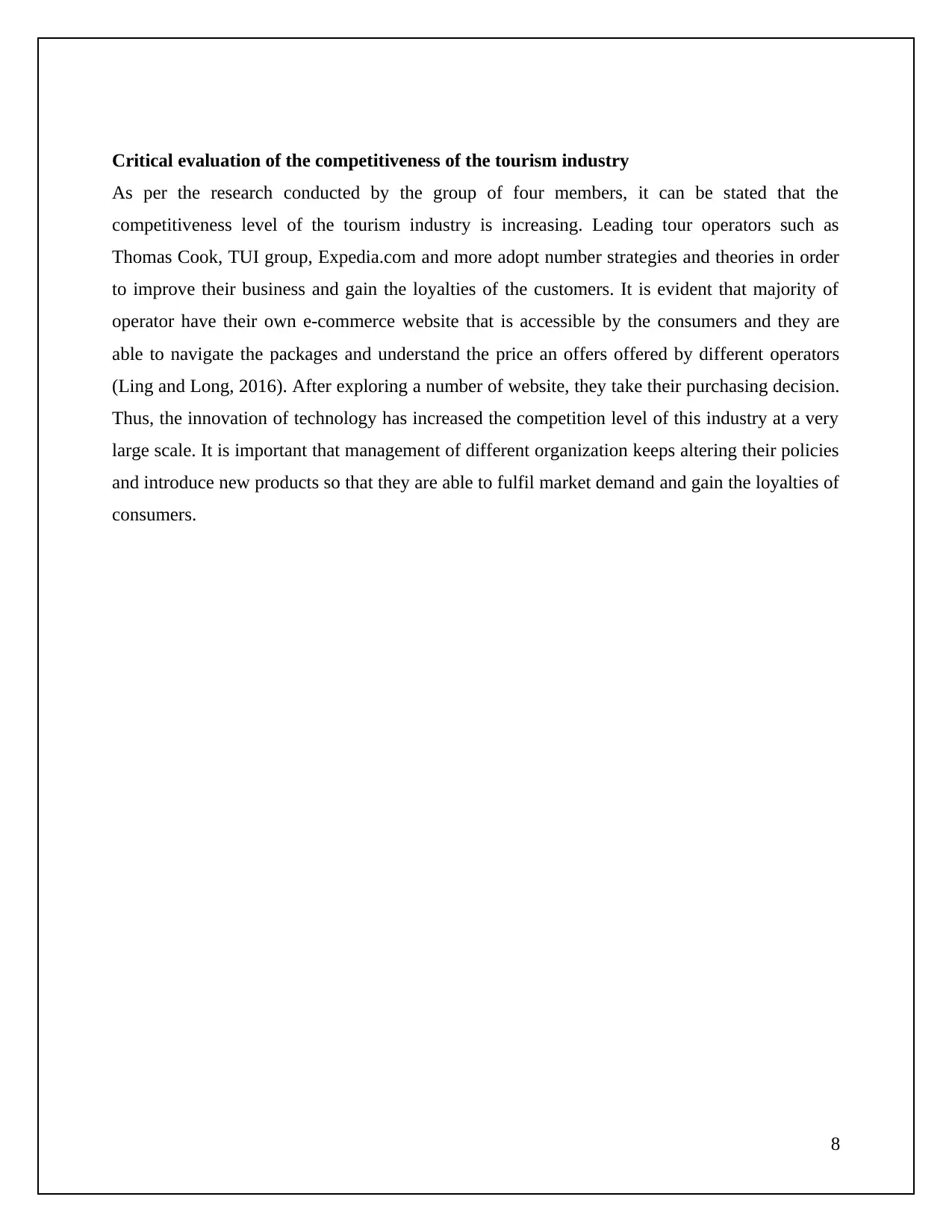
Critical evaluation of the competitiveness of the tourism industry
As per the research conducted by the group of four members, it can be stated that the
competitiveness level of the tourism industry is increasing. Leading tour operators such as
Thomas Cook, TUI group, Expedia.com and more adopt number strategies and theories in order
to improve their business and gain the loyalties of the customers. It is evident that majority of
operator have their own e-commerce website that is accessible by the consumers and they are
able to navigate the packages and understand the price an offers offered by different operators
(Ling and Long, 2016). After exploring a number of website, they take their purchasing decision.
Thus, the innovation of technology has increased the competition level of this industry at a very
large scale. It is important that management of different organization keeps altering their policies
and introduce new products so that they are able to fulfil market demand and gain the loyalties of
consumers.
8
As per the research conducted by the group of four members, it can be stated that the
competitiveness level of the tourism industry is increasing. Leading tour operators such as
Thomas Cook, TUI group, Expedia.com and more adopt number strategies and theories in order
to improve their business and gain the loyalties of the customers. It is evident that majority of
operator have their own e-commerce website that is accessible by the consumers and they are
able to navigate the packages and understand the price an offers offered by different operators
(Ling and Long, 2016). After exploring a number of website, they take their purchasing decision.
Thus, the innovation of technology has increased the competition level of this industry at a very
large scale. It is important that management of different organization keeps altering their policies
and introduce new products so that they are able to fulfil market demand and gain the loyalties of
consumers.
8
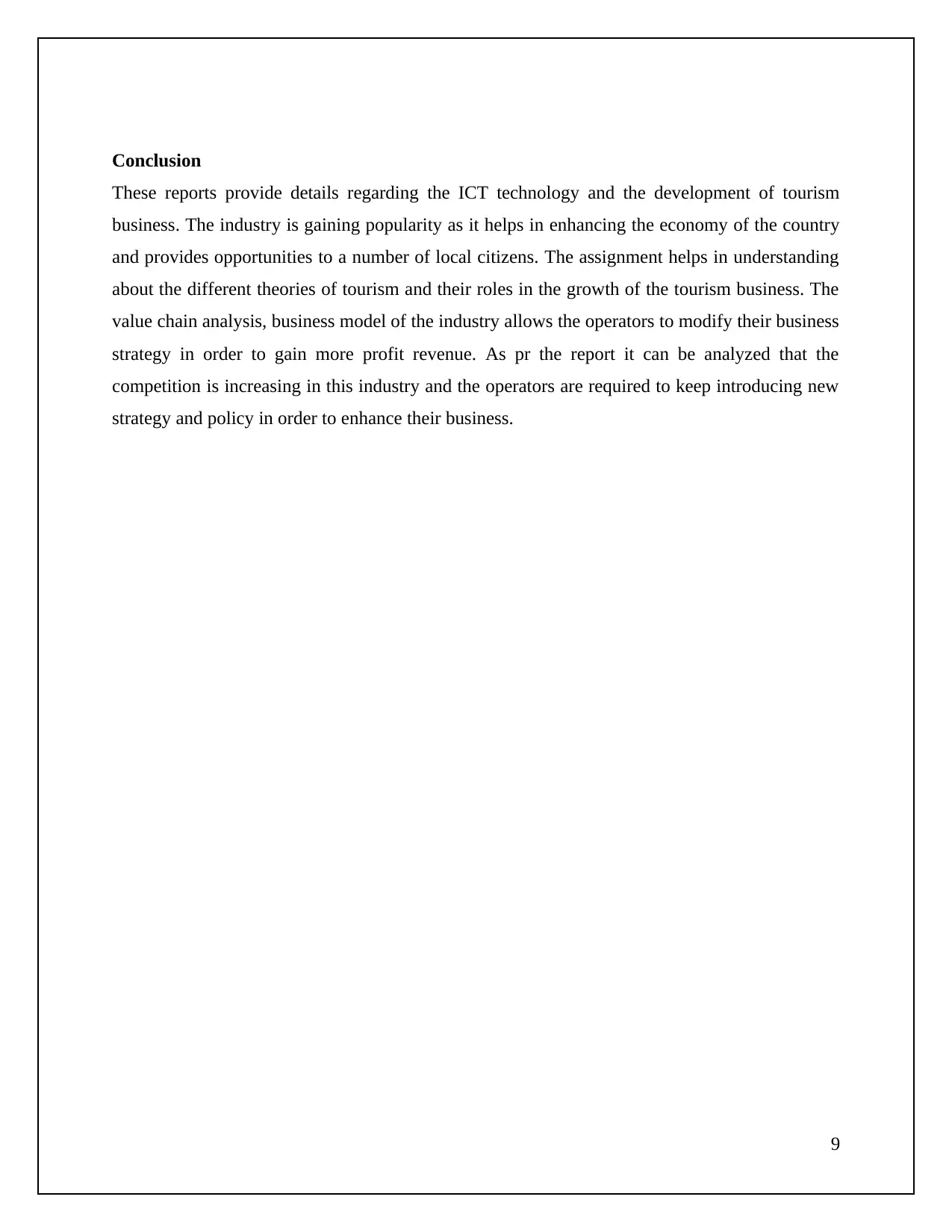
Conclusion
These reports provide details regarding the ICT technology and the development of tourism
business. The industry is gaining popularity as it helps in enhancing the economy of the country
and provides opportunities to a number of local citizens. The assignment helps in understanding
about the different theories of tourism and their roles in the growth of the tourism business. The
value chain analysis, business model of the industry allows the operators to modify their business
strategy in order to gain more profit revenue. As pr the report it can be analyzed that the
competition is increasing in this industry and the operators are required to keep introducing new
strategy and policy in order to enhance their business.
9
These reports provide details regarding the ICT technology and the development of tourism
business. The industry is gaining popularity as it helps in enhancing the economy of the country
and provides opportunities to a number of local citizens. The assignment helps in understanding
about the different theories of tourism and their roles in the growth of the tourism business. The
value chain analysis, business model of the industry allows the operators to modify their business
strategy in order to gain more profit revenue. As pr the report it can be analyzed that the
competition is increasing in this industry and the operators are required to keep introducing new
strategy and policy in order to enhance their business.
9
⊘ This is a preview!⊘
Do you want full access?
Subscribe today to unlock all pages.

Trusted by 1+ million students worldwide
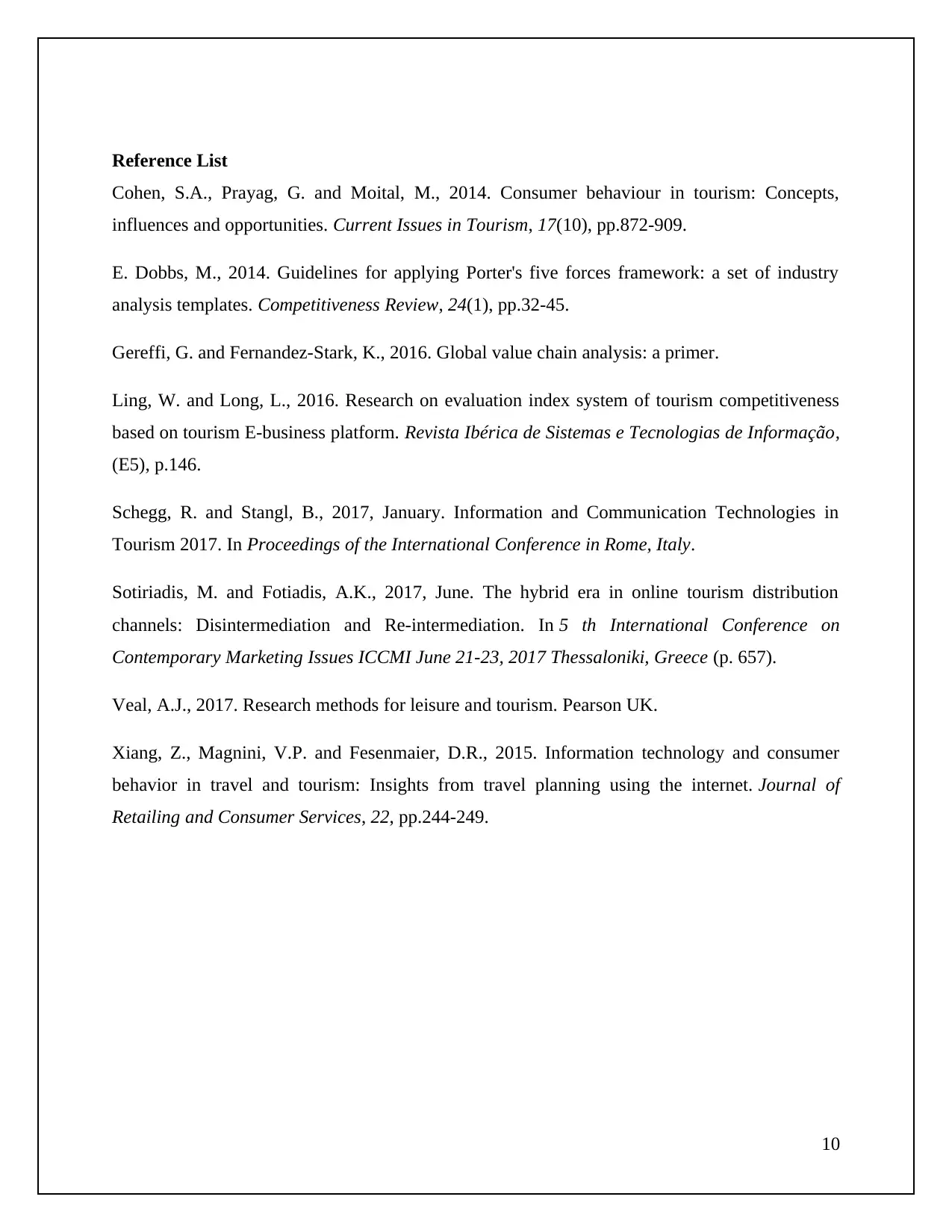
Reference List
Cohen, S.A., Prayag, G. and Moital, M., 2014. Consumer behaviour in tourism: Concepts,
influences and opportunities. Current Issues in Tourism, 17(10), pp.872-909.
E. Dobbs, M., 2014. Guidelines for applying Porter's five forces framework: a set of industry
analysis templates. Competitiveness Review, 24(1), pp.32-45.
Gereffi, G. and Fernandez-Stark, K., 2016. Global value chain analysis: a primer.
Ling, W. and Long, L., 2016. Research on evaluation index system of tourism competitiveness
based on tourism E-business platform. Revista Ibérica de Sistemas e Tecnologias de Informação,
(E5), p.146.
Schegg, R. and Stangl, B., 2017, January. Information and Communication Technologies in
Tourism 2017. In Proceedings of the International Conference in Rome, Italy.
Sotiriadis, M. and Fotiadis, A.K., 2017, June. The hybrid era in online tourism distribution
channels: Disintermediation and Re-intermediation. In 5 th International Conference on
Contemporary Marketing Issues ICCMI June 21-23, 2017 Thessaloniki, Greece (p. 657).
Veal, A.J., 2017. Research methods for leisure and tourism. Pearson UK.
Xiang, Z., Magnini, V.P. and Fesenmaier, D.R., 2015. Information technology and consumer
behavior in travel and tourism: Insights from travel planning using the internet. Journal of
Retailing and Consumer Services, 22, pp.244-249.
10
Cohen, S.A., Prayag, G. and Moital, M., 2014. Consumer behaviour in tourism: Concepts,
influences and opportunities. Current Issues in Tourism, 17(10), pp.872-909.
E. Dobbs, M., 2014. Guidelines for applying Porter's five forces framework: a set of industry
analysis templates. Competitiveness Review, 24(1), pp.32-45.
Gereffi, G. and Fernandez-Stark, K., 2016. Global value chain analysis: a primer.
Ling, W. and Long, L., 2016. Research on evaluation index system of tourism competitiveness
based on tourism E-business platform. Revista Ibérica de Sistemas e Tecnologias de Informação,
(E5), p.146.
Schegg, R. and Stangl, B., 2017, January. Information and Communication Technologies in
Tourism 2017. In Proceedings of the International Conference in Rome, Italy.
Sotiriadis, M. and Fotiadis, A.K., 2017, June. The hybrid era in online tourism distribution
channels: Disintermediation and Re-intermediation. In 5 th International Conference on
Contemporary Marketing Issues ICCMI June 21-23, 2017 Thessaloniki, Greece (p. 657).
Veal, A.J., 2017. Research methods for leisure and tourism. Pearson UK.
Xiang, Z., Magnini, V.P. and Fesenmaier, D.R., 2015. Information technology and consumer
behavior in travel and tourism: Insights from travel planning using the internet. Journal of
Retailing and Consumer Services, 22, pp.244-249.
10
1 out of 10
Related Documents
Your All-in-One AI-Powered Toolkit for Academic Success.
+13062052269
info@desklib.com
Available 24*7 on WhatsApp / Email
![[object Object]](/_next/static/media/star-bottom.7253800d.svg)
Unlock your academic potential
Copyright © 2020–2025 A2Z Services. All Rights Reserved. Developed and managed by ZUCOL.




